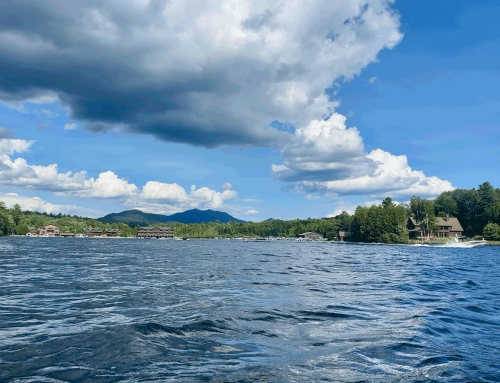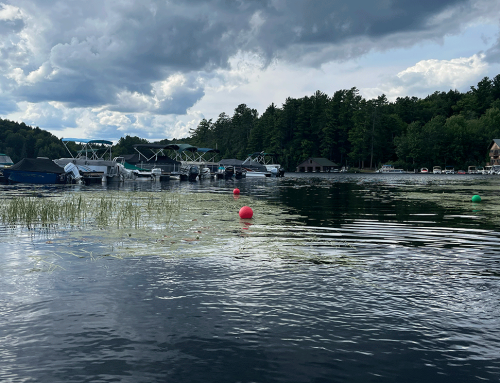A Total Disgrace: oil tankers have arrived in the Adirondack Park and are stored on track in the Forest Preserve
28 Oil Tanker rail cars were transported through Saratoga and Warren counties on October 16th and are stored on rail line along the Boreas River in the Town of Minerva in Essex County
Where is Governor Cuomo? Where is the Department of Environmental Conservation? Where is the Adirondack Park Agency?
On October 16th the first used oil tankers were transported through Saratoga and Warren counties by the Saratoga and North Creek Railway, part of Iowa Pacific Holdings, to a section of siding track along the banks of the Boreas River in the Town of Minerva, Essex County. 28 used oil tankers cars were lined on track north of the North Woods Club Road on rail line traversing the Vanderwhacker Mountain Wild Forest area of the Forest Preserve. Each tanker car is roughly 58 feet in length and the 28 cars lined nearly one-third of a mile of rail track.
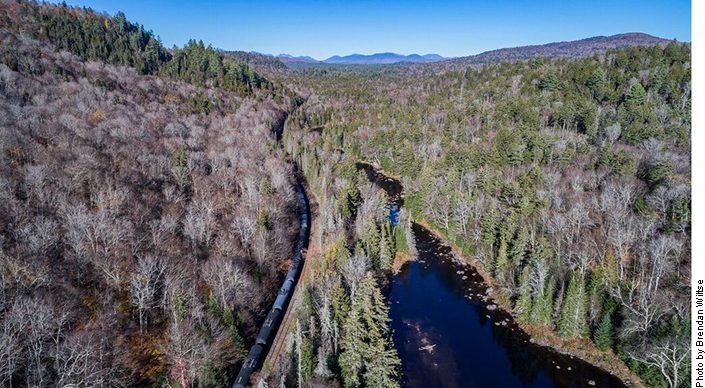
28 out-of-service oil tanker cars are being stored by the Saratoga and North Creek Railroad, owned by Iowa Pacific Holdings, on a stretch of siding track alongside the Boreas River where the track traverses the Vanderwhacker Wild Forest Area of the Adirondack Forest Preserve.
“We must stop the trashing of the Adirondacks with old out-of-service rail cars. Where is Governor Cuomo? Where is the Department of Environmental Conservation? Where is the Adirondack Park Agency? This is a major moment in the history of the Adirondack Park and the forever wild Forest Preserve, yet state leaders are AWOL. This runs counter to everything that the Adirondack Park is all about and must be stopped,” said Peter Bauer, executive director of Protect the Adirondacks.
Click here to get involved and sign an online petition to Governor Cuomo to stop this reckless plan of storing used oil tanker rail cars in the Adirondack Park.
“I am very disappointed with the rail car storage on the Sanford Lake line. The people of Minerva are very proud of their community and work diligently to preserve our history as well as to maintain our properties. I am very concerned not only of the environmental factors of having these cars sitting in the middle of the Adirondack park but also the issue if the trains are on the track the potential of having aggregate from Tahawus shipped to market is mute. These cars also will be stored on a dead end line accessible only thru North Creek and most importantly over an aging train trussel over the Hudson river. There are many groups and individuals who work tirelessly to keep the Adirondack Park as the jewel that it is, but I cannot see how storing these cars goes along with this vision,” said Stephen McNally, Supervisor or the Town of Minerva.
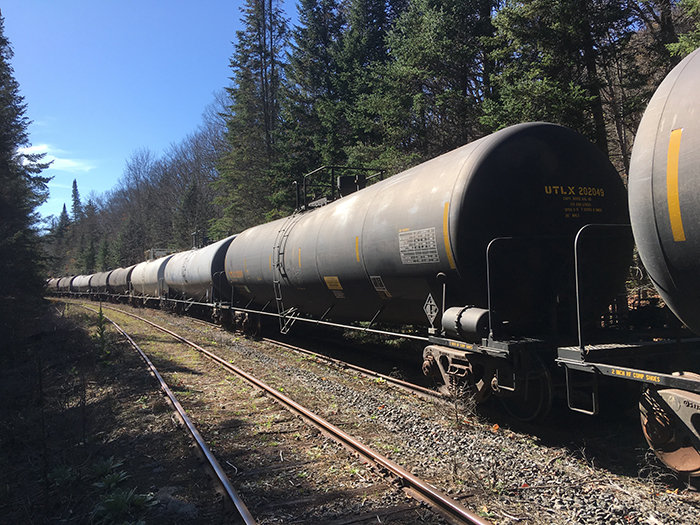
Picture above of out-of-service oil tanker rail cars stored on siding track in the middle of the Vanderwhacker Mountain Wild Forest Area of the Forest Preserve.
Protect the Adirondacks is continuing to investigate the legality of storing used oil tanker cars on the Sanford Lake Railway. This railway was created during World War II, when the federal government condemned an easement to build the rail line using eminent domain under emergency powers, for the express purpose of transporting needed minerals from the Tahawus Mine. Iowa Pacific Holdings now owns this easement, which reverts to the state on Forest Preserve lands and private landowners on private lands, once the rail line ceases operation. The change in use from transport to storage of rail cars raises serious legal issues due to the history of how this rail line was created. Other legal issues involve APA permit jurisdiction for new commercial uses and regulations under the Wild, Scenic and Recreational Rivers Act as well as issues under DEC jurisdiction involving both the Rivers Act and the Forest Preserve management. Legal reviews are also being conducted of regulations under the Surface Transportation Board and Federal Railroad Administration.
There are many questions around this highly controversial activity. We need answers from state agencies about the legality of storing used oil tanker rail cars in the Forest Preserve.
State agencies express concern but fail to act. Where is Governor Andrew Cuomo? Where is the Adirondack Park Agency? Where is the Department of Environmental Conservation?
A week ago two state agencies made statements about their concerns about this ill advised plan, but to date have done nothing. This controversial project needs to be reviewed by the Adirondack Park Agency and Department of Environmental Conservation and information needs to be disclosed to the public. Here are recent statements from these state agencies.
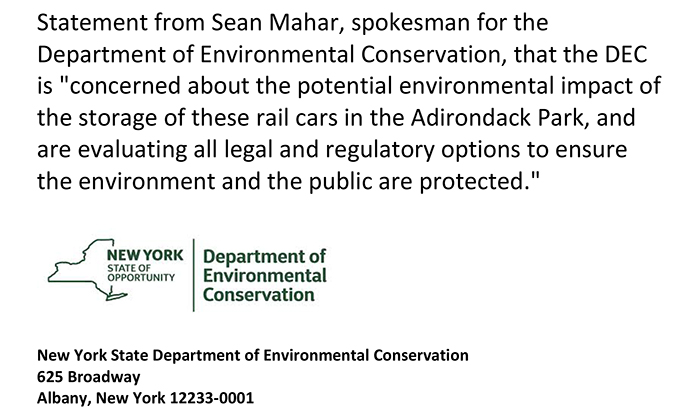
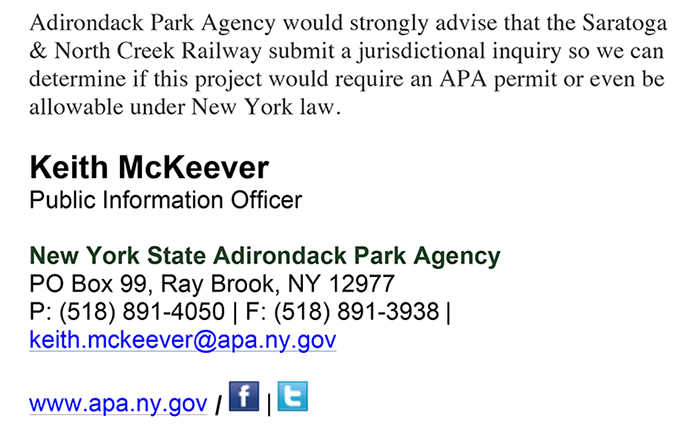
The State Must Reject Plan to Store Used Out-of-Service Oil Tankers on Dormant Adirondack Railways in the Forest Preserve
Saratoga & North Creek Railway stated that it plans to store 2,000 or more out-of-service railroad cars, many being used oil tanker cars. The Adirondack Park has never been used for this purpose. So far, 28 oil tanker rail cars have arrived and are being stored “indefinitely” on these rail lines.
This is a bad idea. Protect the Adirondacks is very concerned about this plan and finds that it contradicts and undermines everything that the Adirondack Park is all about. This proposal threatens the scenic beauty, ecological integrity, and protections for the “forever wild” Forest Preserve. For many reasons we oppose this proposal and we urge the Cuomo Administration to take a stand to protect the Adirondack Park and reject this plan. Quite simply, the Adirondack Park is a region that should not be used for storing waste. There has been a longstanding principle, longer than 30 years, that the Adirondack Park should not be used for storing or disposing of waste from outside the Adirondack Park.
Saratoga & North Creek Railway Must be Desperate if this is their Only Viable Option
The Saratoga & North Creek Railway states that using the rail lines that it owns or leases for storage of old railroad cars is the only way it can money. If this is a reality, then it shows that the scenic railway from Saratoga to North Creek is a failure. Further, if the company continues this activity then it plainly shows that it has no viable business opportunity for using the tailings and rock at the Tahawus Mine as storage of rail cars will block the use of the rail lines for any other purpose.
Iowa Pacific Holdings, which owns the Saratoga and North Creek Railway, has a history of being a poor neighbor in its business practices. The Chicago Tribune published a report about how the company had lined rail cars on its track through Goose Island in Chicago, storing old oil tankers in front of residences and businesses. Iowa Pacific told these people that it would move the cars if it were paid hundreds of thousands of dollars.
The railroad company has also had more than 20 old box cars lined along he banks of the Hudson River, just outside of North Creek, for more than a year and has not provided any public information about when they will be moved.
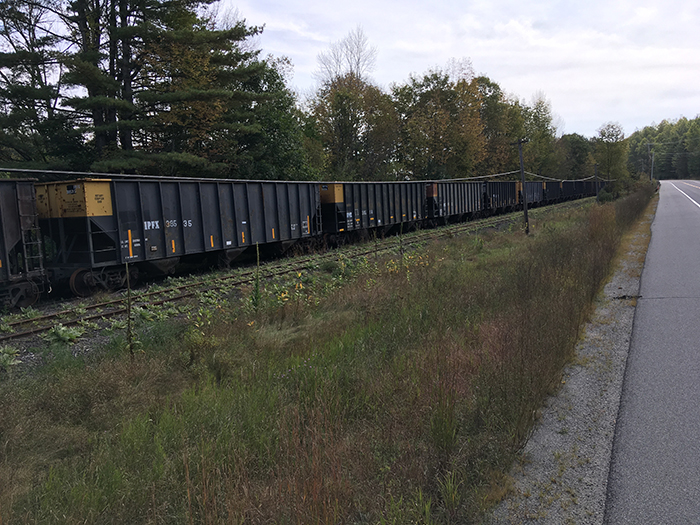
A string of out-of-service boxcars have blocked the view of the Hudson River along Route 28 for more than one year. The Saratoga and North Creek Railway has provided no information when the old boxcars will be removed.
Storage of Used Rail Cars Violates Longstanding APA Precedent to Block the Importation of Garbage and Solid Waste
In the early 1990s, Governor Mario Cuomo stood behind the Adirondack Park Agency (APA) Commissioners when they passed a resolution that the Adirondack Park should be used to handle locally generated garbage and waste, but not used to handle outside waste. This principle was upheld in 1995-1996 by Governor George Pataki, who rebuffed an effort by Essex County leaders to sell the Essex County landfill to a company that wanted to make it a major regional landfill – a giant Fresh Kills Landfill north. We urge your administration to stand with long established precedent and not allow the Saratoga & North Creek Railway to import waste into the Adirondack Park.
Storage of Used Rail Cars Must be Investigated as a Regulated Activity under the APA Act and Environmental Conservation Law
Initial research raises many questions about the regulatory status of a railroad once it is no longer used for transport, but used for long-term storage of rail cars, whether on a main track or siding. Such a transition appears to constitute a new commercial activity that should be subject to local control. We’ve seen many cases over the years where small businesses in the Adirondacks had to secure new commercial use permits from the APA is order to utilize an existing building. We believe that the proposal of Iowa Pacific to utilize the Sanford Lake Rail Line constitutes a new commercial use.
Furthermore, nearly the entire stretch of the Sanford Lake Rail Line is within the classified “Wild” or “Scenic” river corridors of the Boreas or Hudson Rivers. While operating a railroad is a “grandfathered” activity within these protected corridors under the Wild, Scenic and Recreational Rivers Act, the indefinite storage of old railroad cars does not appear to be grandfathered activity, but rather a new use. We also believe that other parts of the Environmental Conservation Law (ECL) must be investigated by the Department of Environmental Conservation (DEC) regarding storage of various waste products.
Visual Blight in the Scenic Adirondacks
Plans to store hundreds of dilapidated rail cars on remote and unused rail lines in the Adirondack Park, mostly in the Forest Preserve, will be a visual blight in the Adirondack landscape. The locations where the railcars will be stored run primarily through the Forest Preserve, including a vast stretch in lands recently purchased by the state along the Hudson River and in areas of the Vanderwhacker Mountain Wild Forest area along the Boreas River. The Sanford Lake Rail Line runs predominantly along the banks of the Hudson or Boreas River and storage in these areas undermines the “forever wild” Forest Preserve. These rail cars will have to be transported on a bridge over the Hudson River where it is run by thousands of rafters every week.
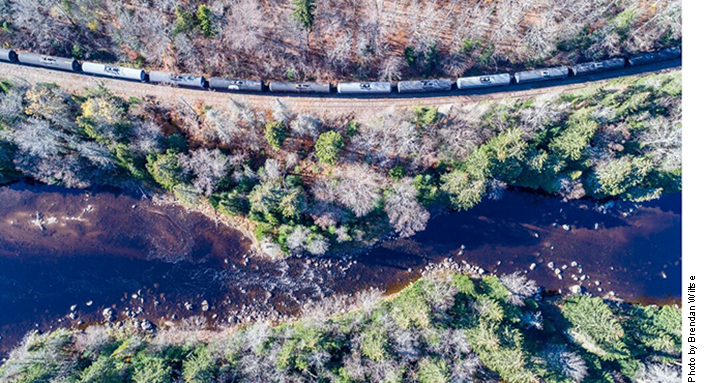
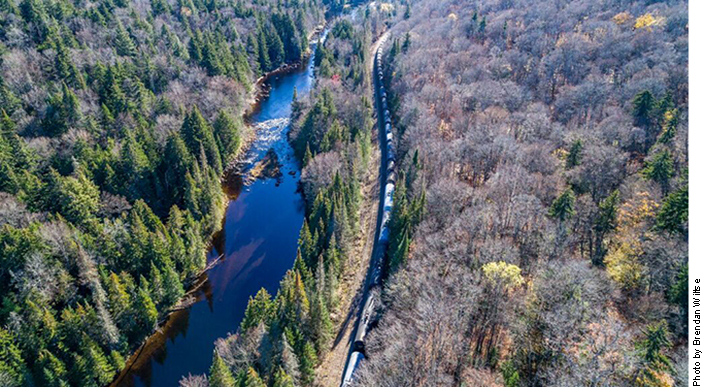
Click here to get involved and sign an online petition to Governor Cuomo to stop this reckless plan of storing used oil tanker rail cars in the Adirondack Park.
A 25-Mile Long Junkyard through the Heart of the Adirondacks
At 58 feet in length, Iowa Pacific Holding Company can store about 90 used oil tankers cars per mile. They have just under 30 miles of track along the Sanford Lake Railway in Hamilton and Essex Counties. We run a great risk with this plan of creating a junkyard that runs 25 miles or more through the heart of the Adirondack Park.
Many Legal Questions about History of Sanford Lake Railroad and Article 14, the Forever Wild Provision of the State Constitution
The unique history of the Sanford Lake Railway raises a number of pressing legal questions about whether it can be used for storage of use oil tanker cars that block the track or whether it can just be used for transport of minerals from the Tahawus Mine. During World War II the federal government condemned an easement through the Forest Preserve and private lands from North Creek to the Tahawus Mine. Unlike many other railroad lines, this one was create solely for one purpose: hauling minerals from the Tahawus Mine. While Iowa Pacific Holdings was greeted with praise for buying the rail line easement after stating the purpose was transporting rock and tailings from the closed mine at Tahawus, it never talked about using the line for storage of railcars.
In addition to the singular purpose for this rail line, the other major factor is that because the line was condemned by eminent domain there is a reversion clause that it should return to the private landowners, and here the State of New York is the largest as long stretches of the Sanford Lake Line pass through the Forest Preserve, should the line cease to be used for the purpose it was obtained through condemnation — transporting minerals. Storage of rail cars has nothing to do with transport of minerals.
The unique history of the Sanford Lake Railway raises important questions about whether rail cars can be stored there. These questions, and others, need to investigated by the State of New York.





